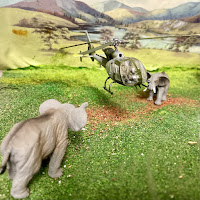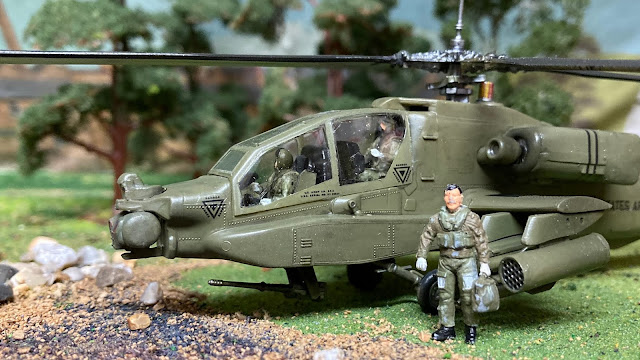For Christmas, I received the gift of Tim Peake's autobiography 'Limitless'. As the subjects of my scale models are inspired by events and observations, it should be no surprise that this inspiring book has steered me to kick off a mini project focussing on 3 of vehicles which feature in the 3 phases of Tim's flying career. The Army Air Corps helicopter pilot, test pilot and astronaut.
Tim Peake's Gazelle
In 1993, at the age of 21, Tim's Army Pilot's Course began. Once he'd mastered the Chipmunk fixed wing training aircraft, it was onto the Gazelle helicopter, nicknamed the 'screaming chicken leg' on account of its shape and high-pitched, whining engine.
After earning his wings, Tim signed up for 4 years of operational service. His first posting as a rotary wing pilot was at Gutersloh in Germany, with 1 Regimental Army Air Corps (AAC) 652 'Chosen Few' Squadron. Here, he learned to ski, parachute and witnessed the failing of the Gazelle's rota blade fixings causing them to be grounded for some time. Apart from routine flying, in the absence of a plane, he would also assist the ACC parachute team with their Friday practice, taking the doors off his Gazelle, removing one of the front seats and fly up to 10,000 feet and let them jump out!

With flying in Germany being a little too tame, in May 1995, Tim opted for a short flying tour in Northern Ireland. Working closely with the RUC and intelligence services, he flew the City Flight, providing overwatch for Belfast city. Having his Gazelle loaded with sights and sensors, attached to a stores boom, and additional armour protection, it was heavier than any he'd previously flown. There were also a couple of new flying manoeuvres to master. Being based at Palace Barracks in the city, necessitated the 'rapid descent landing', to avoid any chance of being shot down as he came in to land. This manoeuvre required him dropping the Gazelle from 3000 feet to the ground, reaching a downward speed of up to 130 mph!


In the spring of 1996, now freshly promoted to captain, Tim was sent on a six-week detachment to Laikipia County, Kenya as flight commander of 652 Squadron's Gazelle flight. Here, his first duty of the day was to take off from his base at Nanyuki, shortly before dawn, to run Exercise Grand Prix. This involved herding elephants off the live firing range at Maple Farm, something which some of the elephants took unkindly to, with the large bull elephants coming close to swatting his helicopter from the sky! As well as flying casualty evacuation and VIP transportation, he also assisted a wildlife conservation team in darting rhinos for tagging purposes; very different flying action to the usual AAC operations. Following this, Tim deployed to Bosnia for Operation Resolute where he dodged AK47 small arms fire and finished his tour by flying the Gazelle the 2,000 km home to Wattisham, Suffolk!
In 1997, with his 4 year tour coming to an end, Tim took his Gazelle to Canada to take part in the BATUS (British Army Training Unit Suffield) military exercises, providing reconnaissance support and casualty evacuations. Following the exercise, he returned to his unit in Germany to complete his operational service, and then moved back to the UK to train as a Qualified Helicopter Instructor, a step closer to becoming a test pilot.
I have painted my Airfix 1:72 scale model of the SA.341 Gazelle in the grey / green camouflage of that Tim's helicopter would have been painted in during his 1995 City Flight and 1996 Kenya assignments. Prior to this, from the 1970s through to the 1982 Falklands War, it would have been seen in its earlier black / green scheme, as depicted on the kit's box and in the instructions.
The 1980s decals were well past their best and the 1970s red, white & blue roundels unsuitable for this variant. I, therefore, had to dig into my extensive spares box for an unused set of XT131 Bell Sioux AH Mk1 'Army' label and 'XT131' serial number and a Sea Harrier's set of small roundels, all of which were just the right size.
The History of the Gazelle
The Westland Gazelle entered service with all branches of the British Armed Forces from 1973/4, with the SA.341B being especially equipped to a specification for the Army Air Corps as the Gazelle AH.1 (from Army Helicopter Mark 1). It was designed by Sud Aviation, later Aérospatiale, and manufactured in France and the United Kingdom through a joint production agreement with Westland Aircraft. Originally based on a French Army requirement for a lightweight observation helicopter, it was enlarged to carry 2 crew and 3 passengers to enable greater versatility and make it more attractive for the export market.
The type was also frequently used to perform airborne patrols in Northern Ireland. On 17 February 1978, a British Army Gazelle crashed near Jonesborough, County Armagh, after coming under fire from the Provisional IRA during a ground skirmish.
During the Falklands War, the RNAS Gazelles operated from the flight decks of Royal Navy ships where they were fitted with 68mm SNEB rocket pods and various other optional equipment such as armour plating, flotation gear and folding blade mechanisms. Two Royal Marines Gazelles were shot down on the first day of the landings at San Carlos Water. In a high-profile incident of friendly fire on 6 June 1982, an Army Air Corps Gazelle was also mistaken for a low-flying Argentine C-130 Hercules and was shot down by HMS Cardiff', a British Type 42 destroyer.

The Gazelle was operated in reconnaissance and liaison roles during the 2007 War in Afghanistan where it was reported that, while many British helicopters had struggled with the conditions of the Afghan and Iraqi theatres, the Gazelle was the "best performing model" with roughly 80% being available for planned operations. Gazelles have also served in other theatres, such as the 1991 Gulf War against Iraq and in the 1999 intervention in Kosovo.
In 2009, the Army Air Corps was the sole operator of the Gazelle with approximately 40 in service with the expectation they be decommissioned in 2012. However, in July 2016, the Ministry of Defence announced that the Gazelle would remain in service until 2025 taking the Gazelle past its 50th anniversary in UK military service and making it the oldest helicopter in active UK inventory.
----
The Model
Brand: Airfix
Title: SA.341 Gazelle
Number: 9-61059
Scale: 1:72
Released: 1981 | Rebox (Changed box only)



























